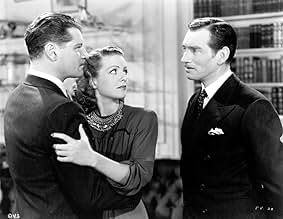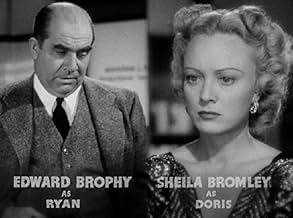Ajouter une intrigue dans votre langueDespite an exclusive contract with the U.S. government, designer Archer Coe's design is being bid on by German, Japanese, and Italian agents - until he's murdered.Despite an exclusive contract with the U.S. government, designer Archer Coe's design is being bid on by German, Japanese, and Italian agents - until he's murdered.Despite an exclusive contract with the U.S. government, designer Archer Coe's design is being bid on by German, Japanese, and Italian agents - until he's murdered.
- Réalisation
- Scénario
- Casting principal
Jimmy Conlin
- Dr. Doremus - Coroner
- (as Jimmy Conlon)
Herbert Anderson
- First Reporter
- (non crédité)
Henry Blair
- Hans Snauble
- (non crédité)
Egon Brecher
- Austrian Judge
- (non crédité)
Avis à la une
This remake of Kennel Murder Case, The (1933) has some good points, but James Stephenson is not one of them. He plays it too impersonal for my taste and pales by comparison with William Powell, who played Vance in the original. But the screenplay, which was updated for the war that loomed on the horizon, was nicely developed, concerning plans for a warplane. The setting was switched to the State Department, with Vance an employed investigator instead of a private eye. I really enjoyed how he used diagrams to explain the movement of the people involved in the murder of the warplane designer, so that in the end, the actions of all were clear. The film also had the advantage of having Edward Brophy in the Sergeant Heath role (here he's called Ryan), bringing comedy without the stupidity of the Heath character. It was rather fun to watch.
This is an adequate afternoon B-feature that probably served more as a warning against fifth-columnists than it actually entertained anyone. It all centres around attempts by the Axis powers to obtain access to the designs of "Archer Coe" (the briefest of appearances from Richard Kipling). Now he has an exclusive arrangement with the Americans so when he is found murdered, it falls to the wily, suspicions and tenacious "Vance" (James Stephenson) to find out who the killers were and on whose malevolent behalf they were working? Did they manage to steal his secret plans? Now this is just a substantial reworking of "The Kennel Murder Case" (1933) - even down to whopping great chunks of the script being transferred, albeit updated, to allow for it's WWII scenario. Although all pretty lightweight and devoid of any real sense of jeopardy, Stephenson is actually quite engaging and there is a decent supporting effort from Edward Trophy ("Ryan") delivering some fun to this rather dry, procedural, crime drama. It's only an hour, and if you like the genre then there isn't really anything not to like - or memorable - about this.
Willard Wright had written murder stories from 1929 - 1939, and created the character Philo Vance. Various people played the Vance character in films over the years, and were written under the name S.S. Van Dine. His addictions contributed to his early death at age 51. In our story, Vance (James Stephenson) is traveling around europe under an assumed name, and when they try to keep him in Germany, he escapes and pops back up in America. Keep an eye out for better-known Ed Brophy as his co-worker "Ryan". This one a a remake of Warner Brothers' own very successful Kennel Murder Case from 1933. By this time, europe was getting esconced in spies and a brewing war, so now its all about stolen fighter plane plans. this one has the usual side gags... the bumbling police, and the muttering medical examiner who is called in every time there's another murder. This one has more of a steady plot line, and a smooth plot line, since it is a remake. Pretty good. Directed by William Clemens, who also directed a bunch of the "Falcon" films.
While I do like JAMES STEPHENSON as an actor (he was excellent in THE LETTER with Bette Davis), he lacks the sort of debonair charm needed for the role of Philo Vance in CALLING PHILO VANCE. However, that's not integral to your enjoyment of this updating of "The Kennel Murder Case" which was made in '40 when the Nazis were making big strides during World War II.
Secret stolen plans for a bomber falling into the hands of German agents is the crux of the matter here, to the tune of $250,000. The story begins with Vance accepting an assignment in Vienna where he is trying to find out whether Archer Coe is selling aircraft plans to a foreign country. But the main story begins when he's deported to the U.S., escapes authorities and returns to investigate the case for Chief Investigator Markham (HENRY O'NEILL).
The wealthy household where Coe died in a locked room, is at first ruled as the scene of a suicide but soon evidence proves it to be a murder and there are several suspects--among them, RALPH FORBES, DONALD DOUGLAS and MARTIN KOSLECK, in an unusual role as a butler. Kosleck usually played German spies in all the Warner war films.
Under Stanely Clements' direction, the tale moves quickly to an all too abrupt conclusion with very little explanation given for the intricate murder plot. While not exactly plausible, it does make an interesting mystery for who-dun-it fans with some clever touches in the script.
But the main disappointment lies in not having a satisfactory actor in the Philo Vance role.
Secret stolen plans for a bomber falling into the hands of German agents is the crux of the matter here, to the tune of $250,000. The story begins with Vance accepting an assignment in Vienna where he is trying to find out whether Archer Coe is selling aircraft plans to a foreign country. But the main story begins when he's deported to the U.S., escapes authorities and returns to investigate the case for Chief Investigator Markham (HENRY O'NEILL).
The wealthy household where Coe died in a locked room, is at first ruled as the scene of a suicide but soon evidence proves it to be a murder and there are several suspects--among them, RALPH FORBES, DONALD DOUGLAS and MARTIN KOSLECK, in an unusual role as a butler. Kosleck usually played German spies in all the Warner war films.
Under Stanely Clements' direction, the tale moves quickly to an all too abrupt conclusion with very little explanation given for the intricate murder plot. While not exactly plausible, it does make an interesting mystery for who-dun-it fans with some clever touches in the script.
But the main disappointment lies in not having a satisfactory actor in the Philo Vance role.
Warner Brothers probably of all the studios loved remaking its films. I guess Jack Warner thought it saved on buying new properties. Calling Philo Vance after a brief prologue updating the story to have Vance working for the State Department investigating the theft of airplane designs, it becomes almost a word for word remake of The Kennel Murder Case. Even the character names remain the same. Whole bits of dialog from the original are reused in this one.
Too bad they couldn't have gotten William Powell as well. But he was over at MGM keeping Nora and Asta in line. So James Stephenson became the latest in a long line of Vances. Philo Vance would soon fade from the screen.
Stephenson is serviceable, but lacks Powell's unique debonair charm. And of course we've seen it all before.
Too bad they couldn't have gotten William Powell as well. But he was over at MGM keeping Nora and Asta in line. So James Stephenson became the latest in a long line of Vances. Philo Vance would soon fade from the screen.
Stephenson is serviceable, but lacks Powell's unique debonair charm. And of course we've seen it all before.
Le saviez-vous
- AnecdotesAll the scenes involving the two murdered men are taken directly from the earlier mystery called Meurtre au chenil (1933), in which William Powell played Philo Vance. In both movies, most of the dialog in the scenes pertaining to the murders and the investigation is exactly the same, word-for-word, which clearly indicates that the script from the 1933 film was adapted to the story for this film, which focuses on the theft of secret aircraft plans. However, in "The Kennel Murder Case", the plot concerns stolen Chinese art objects.
- GaffesRalph Forbes is credited onscreen as "Tom MacDonald," but throughout the film, he is called Taylor MacDonald.
- Citations
Dr. Doremus - Coroner: [about the dead Archer Coe] There couldn't have been much of a struggle. His hair isn't even mussed.
Ryan: [Sardonically] Somebody must have blackjacked him and then combed his hair.
- ConnexionsFeatured in Inside the Dream Factory (1995)
- Bandes originalesI'm Happy About the Whole Thing
(uncredited)
Music by Harry Warren
Played when Vance and Ryan meet Grassi in the bar
Meilleurs choix
Connectez-vous pour évaluer et suivre la liste de favoris afin de recevoir des recommandations personnalisées
Détails
- Date de sortie
- Pays d’origine
- Langues
- Aussi connu sous le nom de
- Philo Vance Comes Back
- Lieux de tournage
- Société de production
- Voir plus de crédits d'entreprise sur IMDbPro
- Durée1 heure 2 minutes
- Couleur
- Mixage
- Rapport de forme
- 1.37 : 1
Contribuer à cette page
Suggérer une modification ou ajouter du contenu manquant

Lacune principale
By what name was Calling Philo Vance (1939) officially released in Canada in English?
Répondre


































